新编简明英语语言学知识点汇总
- 格式:docx
- 大小:95.06 KB
- 文档页数:13
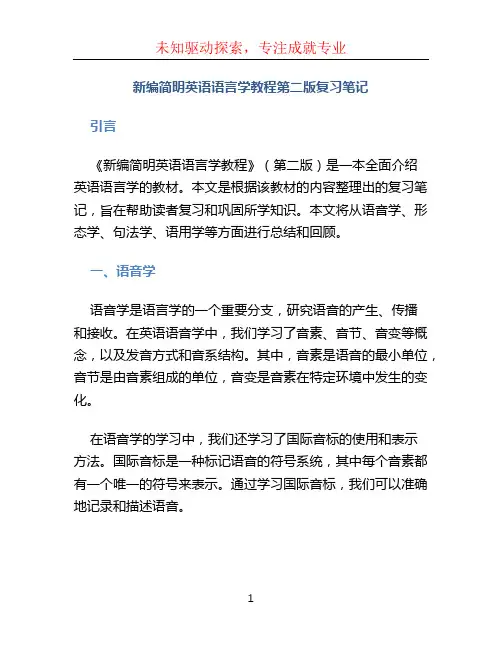
新编简明英语语言学教程第二版复习笔记引言《新编简明英语语言学教程》(第二版)是一本全面介绍英语语言学的教材。
本文是根据该教材的内容整理出的复习笔记,旨在帮助读者复习和巩固所学知识。
本文将从语音学、形态学、句法学、语用学等方面进行总结和回顾。
一、语音学语音学是语言学的一个重要分支,研究语音的产生、传播和接收。
在英语语音学中,我们学习了音素、音节、音变等概念,以及发音方式和音系结构。
其中,音素是语音的最小单位,音节是由音素组成的单位,音变是音素在特定环境中发生的变化。
在语音学的学习中,我们还学习了国际音标的使用和表示方法。
国际音标是一种标记语音的符号系统,其中每个音素都有一个唯一的符号来表示。
通过学习国际音标,我们可以准确地记录和描述语音。
二、形态学形态学是研究词素和词法规则的学科。
在形态学中,我们学习了词的构成规则和形态变化。
英语中的词缀是词的构成要素,可以分为前缀、后缀和中缀。
词缀的加入或删除可以改变词的意思、词性或词态。
此外,我们还学习了各种词的形态变化规则,如名词的复数形式、动词的时态和语气等。
了解形态学规则对于理解和运用英语词汇是非常重要的。
三、句法学句法学是研究句子结构和句子成分之间关系的学科。
在句法学的学习中,我们学习了句子的基本成分,如主语、谓语、宾语和定语等。
我们还学习了句子的结构、成分之间的语法关系,以及句法规则的应用。
在英语句法学中,我们学习了句子的短语结构分析和句子树的表示方法。
通过短语结构分析和句子树,我们可以准确地分析句子的结构和成分关系。
四、语用学语用学研究的是语言的使用和交际。
在语用学的学习中,我们学习了语言的交际功能、意义和上下文的影响。
我们还学习了言语行为和语用规则,如请求、邀请、命令等。
了解语用学对于理解和运用英语是非常重要的。
结论《新编简明英语语言学教程》(第二版)是一本重要的英语语言学教材,其内容涵盖了语音学、形态学、句法学和语用学等方面的知识。
本文对该教材的内容进行了复习总结,并通过Markdown文本格式进行了输出。
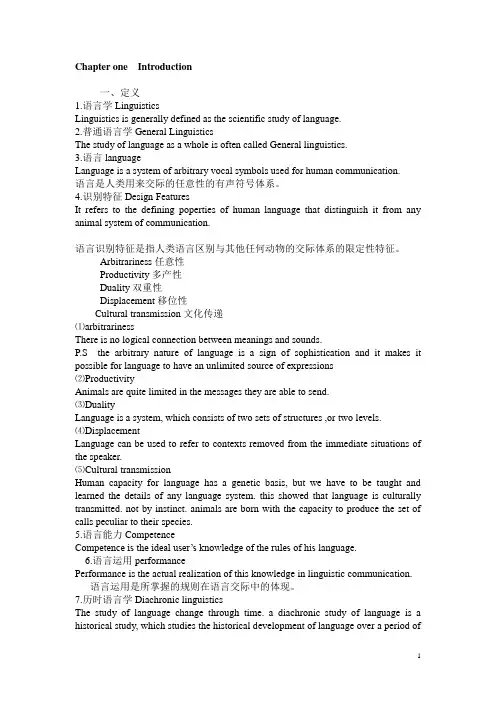
Chapter one Introduction一、定义1.语言学LinguisticsLinguistics is generally defined as the scientific study of language.2.普通语言学General LinguisticsThe study of language as a whole is often called General linguistics.3.语言languageLanguage is a system of arbitrary vocal symbols used for human communication.语言是人类用来交际的任意性的有声符号体系。
4.识别特征Design FeaturesIt refers to the defining poperties of human language that distinguish it from any animal system of communication.语言识别特征是指人类语言区别与其他任何动物的交际体系的限定性特征。
Arbitrariness任意性Productivity多产性Duality双重性Displacement移位性Cultural transmission文化传递⑴arbitrarinessThere is no logical connection between meanings and sounds.P.S the arbitrary nature of language is a sign of sophistication and it makes it possible for language to have an unlimited source of expressions⑵ProductivityAnimals are quite limited in the messages they are able to send.⑶DualityLanguage is a system, which consists of two sets of structures ,or two levels.⑷DisplacementLanguage can be used to refer to contexts removed from the immediate situations of the speaker.⑸Cultural transmissionHuman capacity for language has a genetic basis, but we have to be taught and learned the details of any language system. this showed that language is culturally transmitted. not by instinct. animals are born with the capacity to produce the set of calls peculiar to their species.5.语言能力CompetenceCompetence is the ideal user’s knowledge of the rules of his language.6.语言运用performancePerformance is the actual realization of this knowledge in linguistic communication.语言运用是所掌握的规则在语言交际中的体现。
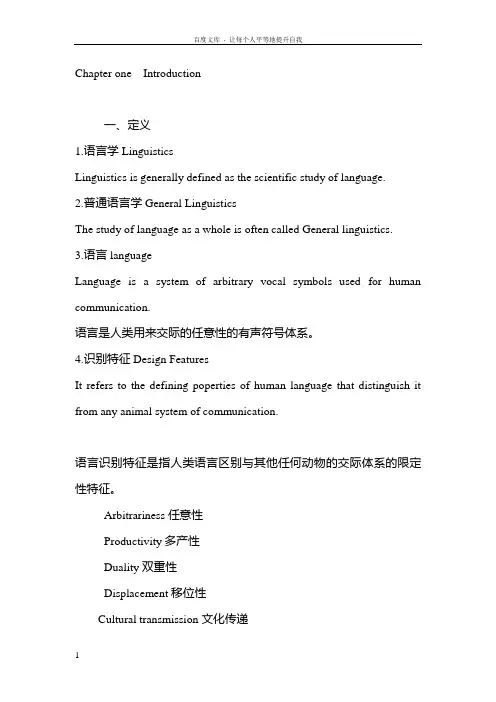
Chapter one Introduction一、定义1.语言学LinguisticsLinguistics is generally defined as the scientific study of language.2.普通语言学General LinguisticsThe study of language as a whole is often called General linguistics.3.语言languageLanguage is a system of arbitrary vocal symbols used for human communication.语言是人类用来交际的任意性的有声符号体系。
4.识别特征Design FeaturesIt refers to the defining poperties of human language that distinguish it from any animal system of communication.语言识别特征是指人类语言区别与其他任何动物的交际体系的限定性特征。
Arbitrariness任意性Productivity多产性Duality双重性Displacement移位性Cultural transmission文化传递⑴arbitrarinessThere is no logical connection between meanings and sounds.the arbitrary nature of language is a sign of sophistication and it makes it possible for language to have an unlimited source of expressions⑵ProductivityAnimals are quite limited in the messages they are able to send.⑶DualityLanguage is a system, which consists of two sets of structures ,or two levels.⑷DisplacementLanguage can be used to refer to contexts removed from the immediate situations of the speaker.⑸Cultural transmissionHuman capacity for language has a genetic basis, but we have to be taught and learned the details of any language system. this showed that language is culturally transmitted. not by instinct. animals are born with the capacity to produce the set of calls peculiar to their species.5.语言能力CompetenceCompetence is the ideal user’s knowledge of the rules of his lan guage. 6.语言运用performancePerformance is the actual realization of this knowledge in linguistic communication.语言运用是所掌握的规则在语言交际中的体现。
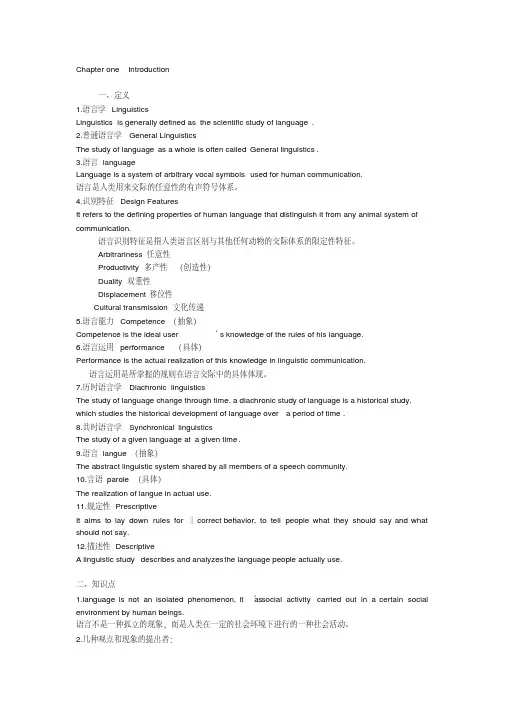
Chapter one Introduction一、定义1.语言学LinguisticsLinguistics is generally defined as the scientific study of language.2.普通语言学General LinguisticsThe study of language as a whole is often called General linguistics.3.语言languageLanguage is a system of arbitrary vocal symbols used for human communication.语言是人类用来交际的任意性的有声符号体系。
4.识别特征Design FeaturesIt refers to the defining properties of human language that distinguish it from any animal system of communication.语言识别特征是指人类语言区别与其他任何动物的交际体系的限定性特征。
Arbitrariness任意性Productivity多产性(创造性)Duality双重性Displacement移位性Cultural transmission文化传递5.语言能力Competence(抽象)Competence is the ideal user‘s knowledge of the rules of his language.6.语言运用performance(具体)Performance is the actual realization of this knowledge in linguistic communication.语言运用是所掌握的规则在语言交际中的具体体现。
7.历时语言学Diachronic linguisticsThe study of language change through time. a diachronic study of language is a historical study, which studies the historical development of language over a period of time.8.共时语言学Synchronical linguisticsThe study of a given language at a given time.9.语言langue(抽象)The abstract linguistic system shared by all members of a speech community.10.言语parole(具体)The realization of langue in actual use.11.规定性Prescriptivebehavior, to tell people what they should say and what It aims to lay down rules for ‖correct‖ should not say.12.描述性DescriptiveA linguistic study describes and analyzes the language people actually use.二、知识点a social activity carried out in a certain socialnguage is not an isolated phenomenon, it‘senvironment by human beings.语言不是一种孤立的现象,而是人类在一定的社会环境下进行的一种社会活动。
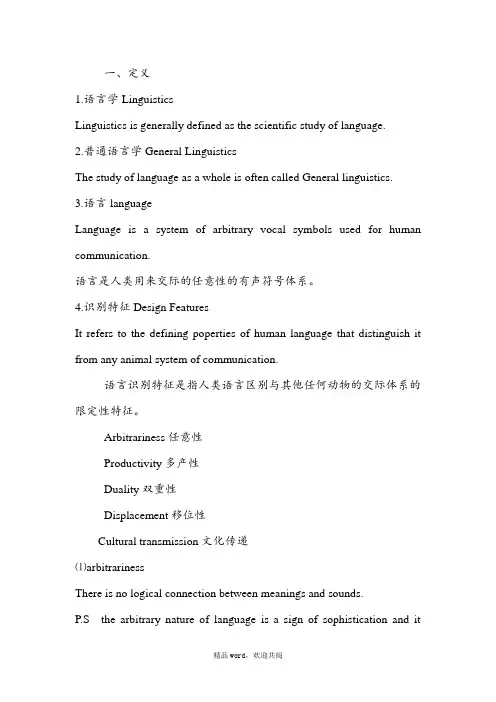
一、定义1.语言学LinguisticsLinguistics is generally defined as the scientific study of language.2.普通语言学General LinguisticsThe study of language as a whole is often called General linguistics.3.语言languageLanguage is a system of arbitrary vocal symbols used for human communication.语言是人类用来交际的任意性的有声符号体系。
4.识别特征Design FeaturesIt refers to the defining poperties of human language that distinguish it from any animal system of communication.语言识别特征是指人类语言区别与其他任何动物的交际体系的限定性特征。
Arbitrariness任意性Productivity多产性Duality双重性Displacement移位性Cultural transmission文化传递⑴arbitrarinessThere is no logical connection between meanings and sounds.P.S the arbitrary nature of language is a sign of sophistication and itmakes it possible for language to have an unlimited source of expressions ⑵ProductivityAnimals are quite limited in the messages they are able to send.⑶DualityLanguage is a system, which consists of two sets of structures ,or two levels.⑷DisplacementLanguage can be used to refer to contexts removed from the immediate situations of the speaker.⑸Cultural transmissionHuman capacity for language has a genetic basis, but we have to be taught and learned the details of any language system. this showed that language is culturally transmitted. not by instinct. animals are born with the capacity to produce the set of calls peculiar to their species.5.语言能力CompetenceCompetence is the ideal user’s knowledge of the rules of his language. 6.语言运用performancePerformance is the actual realization of this knowledge in linguistic communication.语言运用是所掌握的规则在语言交际中的体现。

简明英语语言学知识点汇总Document number【AA80KGB-AA98YT-AAT8CB-2A6UT-A18GG】新编简明英语语言学知识点汇总1 Introduction1.1 What is linguistics?Scientific study of language.Interpretation:①try to answer the basic questions and probe into various problems related to language;②linguistics studies not any particular language but language in general;③scientific study because based on systematic investigation of linguistic data.1.1.2 The scope of linguisticsThe study of language as a whole is often called general linguistic.1.1.3 Some important distinctions in linguistics1.2 What is language1.2.1 Definitions of languageLanguage is a system of arbitrary vocal symbols used for human communication.Characteristics:①language is system,elements of language are combined according to the rules;②language is arbitrary in the sense that there is no intrinsic connection between a linguistic symbol and what it stands for,A rose by any other name would smell as well;③language is vocal because the primary medium for all language is sound;④language is human -specific,different from animal communication.1.2.2 Design features of languageProposed by American linguist Charles Hockett:comparing the animal & human communication systems.Following are five major design features of human language:①arbitrarinessNo logical connection between meaning and sounds(except onomatopoetic and compound words)②productivityIt makes to possible to construction and interpretation of new signal by its users.③dualityLanguage is a system which consists of two structures. At the lower level there is a structure of sounds,which are meaningless by themselves.But the sounds can grouped or regrouped together into a larger numbers of units of meaningsuch as morpheme or words,which are found at the higher levelof system(carp & park).Then the higher level can be arrangedand rearranged into an infinite numbers of sentences;④DisplacementLanguage can be used to refer to contexts removed from the immediate situations of the speakers;⑤cultural transmissionWhile human capacity for language has a genetic basis,thedetails of any language systems are not genetically transmitted, but instead have to be taught and learned.(language is cultural transmitted[language not mutually intelligible] while animalcall system is genetically transmitted)1.2.3 Functions of languageThree main functions of language which distinct from each other but actually overlapping to some degree:①descriptive functionThe primary function of language;The Sichuan earthquake is the most serious one China has ever suffered.②expressive functionSupply information about the user’sfeeling,preference,prejudices and value,etc.I will never come to this coffee shop again.③social functionServes to establish and maintain social relations between people. How can I help you, Sir?Others:Russian-born structural linguist Roman Jakobson:six elemens (function)of a speech:Addresser-emotive (动机) addressee-conative(意动) context-referential message-poetic contact-phatic communioncode-metalinguisticBritish linguistic M.A.K Halliday:①ideational function(语篇功能)[included descriptive & expressive functin] is to organize the speaker’s experience of the real or imaginary world.②interpersonal function is to indicate ,establish,or maintain social relationship between people.[social function]③textual function is to organize written or spoken texts to cohere within themselves and fit to the particular situation in which they are used.2.Phonology2.1 The phonic medium of languageSpeech sounds produced by human speech organTwo major media of communication:speech and writing;2.2phonetics2.2.1 what is phonetics?The study of phonic medium of language;it is concerned with all the sounds that occurs in the world’s language.发音语言学听觉语言学)声学语言学)2.2.2 organs of speechPharyngeal cavity(咽喉)Nasal cavity(鼻腔)Oral cavity(口腔)Voicing:vibration of the vocal cordsNarrow: letter symbols + diacritics(变音符)[p h it] [spit] h→aspiration [phonetician more interested in]2.2.4 classification of English speech soundsMonophthongs:2.3 phonology2.3.1 phonology & phoneticsStem: believable (除掉所有的语法成份,Base:unbelievable (un的词基)Prefix:change meaningSuffix: change meaning and parts of speechInflectional morpheme:signify tense number caseWord formation:①Clipping(shortening & abbreviation)[no change of part of speech]I.e gym expo memo disco burger quake fridge script②back-formation[change of part of speech]I.e editor-edit hawker-hawk beggar-beg baby-sister--baby-sitButcher-butch donation-donate orientation-orient(ate)③conversion(functional shift)I.e: N-v v-n a-v a-n④acronyms[pronounced as words]CEO B2B IT CPI IAD WTO BBS(FOR BULLETIN BOARD SYSTEM)APEC AIDS UNESCO UCLA IDD⑤initialism[produced as letters]C.O.D FBI EEC⑥blendingSmoke+fog=smogTaikong+astronaut=taikonaut⑦compoundingBittersweet landlady⑧onomatopoeiaBlast rustle5.SemanticsSome views concerning the study of meaning:1)the naming theory,plato,words →objectsLimitations: √N ×ADJ ADV V√Concrete ×abstract2)the conceptualist viewSemantic triangle,ogden & richardswords→mind→wordsLimitations:what is the precisely link symbol and concept unclarify3)ContextualismJ.R Firth。
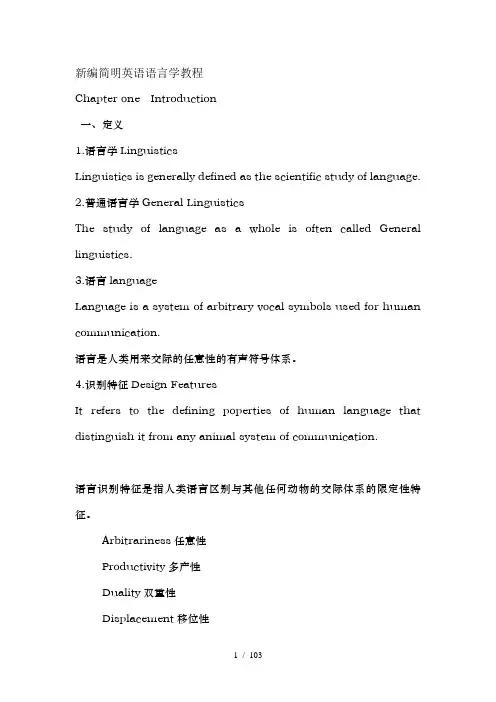
新编简明英语语言学教程Chapter one Introduction一、定义1.语言学LinguisticsLinguistics is generally defined as the scientific study of language.2.普通语言学General LinguisticsThe study of language as a whole is often called General linguistics.3.语言languageLanguage is a system of arbitrary vocal symbols used for human communication.语言是人类用来交际的任意性的有声符号体系。
4.识别特征Design FeaturesIt refers to the defining poperties of human language that distinguish it from any animal system of communication.语言识别特征是指人类语言区别与其他任何动物的交际体系的限定性特征。
Arbitrariness任意性Productivity多产性Duality双重性Displacement移位性Cultural transmission文化传递⑴arbitrarinessThere is no logical connection between meanings and sounds. P.S the arbitrary nature of language is a sign of sophistication and it makes it possible for language to have an unlimited source of expressions⑵ProductivityAnimals are quite limited in the messages they are able to send.⑶DualityLanguage is a system, which consists of two sets of structures ,or two levels.⑷DisplacementLanguage can be used to refer to contexts removed from the immediate situations of the speaker.⑸Cultural transmissionHuman capacity for language has a genetic basis, but we have to be taught and learned the details of any language system. this showed that language is culturally transmitted. not by instinct. animals are born with the capacity to produce the set of calls peculiar to their species.5.语言能力CompetenceCompetence is the ideal user’s knowledge of the rules of h islanguage.6.语言运用performancePerformance is the actual realization of this knowledge in linguistic communication.语言运用是所掌握的规则在语言交际中的体现。

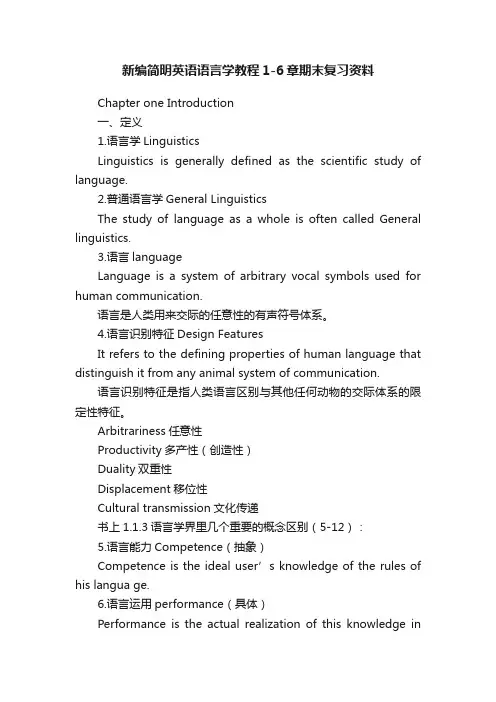
新编简明英语语言学教程1-6章期末复习资料Chapter one Introduction一、定义1.语言学LinguisticsLinguistics is generally defined as the scientific study of language.2.普通语言学General LinguisticsThe study of language as a whole is often called General linguistics.3.语言languageLanguage is a system of arbitrary vocal symbols used for human communication.语言是人类用来交际的任意性的有声符号体系。
4.语言识别特征Design FeaturesIt refers to the defining properties of human language that distinguish it from any animal system of communication.语言识别特征是指人类语言区别与其他任何动物的交际体系的限定性特征。
Arbitrariness任意性Productivity多产性(创造性)Duality双重性Displacement移位性Cultural transmission文化传递书上1.1.3语言学界里几个重要的概念区别(5-12):5.语言能力Competence(抽象)Competence is the ideal user’s knowledge of the rules of his langua ge.6.语言运用performance(具体)Performance is the actual realization of this knowledge inlinguistic communication.语言运用是所掌握的规则在语言交际中的具体体现。

英语学习新编简明英语语言学教程笔记必备-CAL-FENGHAI.-(YICAI)-Company One1弃我去者,昨日之日不可留乱我心者,今日之日多烦忧Chapter one Introduction一、定义1.语言学LinguisticsLinguistics is generally defined as the scientific study of language.2.普通语言学General LinguisticsThe study of language as a whole is often called General linguistics.3.语言languageLanguage is a system of arbitrary vocal symbols used for human communication.语言是人类用来交际的任意性的有声符号体系。
4.识别特征Design FeaturesIt refers to the defining poperties of human language that distinguish it from any animal system of communication.语言识别特征是指人类语言区别与其他任何动物的交际体系的限定性特征。
Arbitrariness任意性Productivity多产性Duality双重性Displacement移位性Cultural transmission文化传递⑴arbitrarinessThere is no logical connection between meanings and sounds.P.S the arbitrary nature of language is a sign of sophistication and it makes it possible for language to have an unlimited source of expressions⑵ProductivityAnimals are quite limited in the messages they are able to send.⑶DualityLanguage is a system, which consists of two sets of structures ,or two levels.⑷DisplacementLanguage can be used to refer to contexts removed from the immediate situations of the speaker.⑸Cultural transmissionHuman capacity for language has a genetic basis, but we have to be taught and learned the details of any language system. this showed that language is culturally transmitted. not by instinct. animals are born with the capacity to produce the set of calls peculiar to their species.5.语言能力CompetenceCompet ence is the ideal user’s knowledge of the rules of his language.6.语言运用performancePerformance is the actual realization of this knowledge in linguistic communication. 语言运用是所掌握的规则在语言交际中的体现。
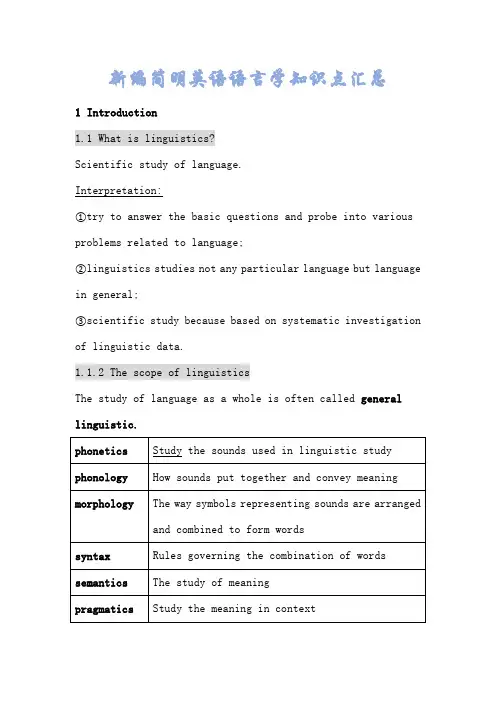
新编简明英语语言学知识点汇总1 Introduction1.1 What is linguistics?Scientific study of language.Interpretation:①try to answer the basic questions and probe into various problems related to language;②linguistics studies not any particular language but language in general;③scientific study because based on systematic investigation of linguistic data.1.1.2 The scope of linguisticsThe study of language as a whole is often called general linguistic.1.1.3 Some important distinctions in linguistics1.2 What is language1.2.1 Definitions of languageLanguage is a system of arbitrary vocal symbols used for human communication.Characteristics:①language is system,elements of language are combined according to the rules;②language is arbitrary in the sense that there is no intrinsic connection between a linguistic symbol and what it stands for,A rose by any other name would smell as well;③language is vocal because the primary medium for all language is sound;④language is human -specific,different from animal communication.1.2.2 Design features of languageProposed by American linguist Charles Hockett:comparing the animal & human communication systems.Following are five major design features of human language:①arbitrarinessNo logical connection between meaning and sounds(except onomatopoetic and compound words)②productivityIt makes to possible to construction and interpretation of new signal by its users.③dualityLanguage is a system which consists of two structures. At the lower level there is a structure of sounds,which are meaningless by themselves.But the sounds can grouped or regrouped together into a larger numbers of units of meaning such as morpheme or words,which are found at the higher level of system(carp & park).Then the higher level can be arranged and rearranged into an infinite numbers of sentences;④DisplacementLanguage can be used to refer to contexts removed from the immediate situations of the speakers;⑤cultural transmissionWhile human capacity for language has a genetic basis,the details of any language systems are not genetically transmitted, but instead have to be taught and learned.(language is cultural transmitted[language not mutually intelligible] while animal call system is genetically transmitted)1.2.3 Functions of languageThree main functions of language which distinct from each other but actually overlapping to some degree:①descriptive functionThe primary function of language;The function to convey factual information, which can be asserted or denial, and in some case even verified.e.g: The Sichuan earthquake is the most serious one China has ever suffered.②expressive functionSupply information about the user’sfeeling,preference,prejudices and value,etc.I will never come to this coffee shop again.③social functionServes to establish and maintain social relations between people. How can I help you, Sir?Others:Russian-born structural linguist Roman Jakobson:six elemens (function)of a speech:Addresser-emotive (动机) addressee-conative(意动)context-referential message-poetic contact-phatic communion code-metalinguisticBritish linguistic M.A.K Halliday:①ideational function(语篇功能)[included descriptive & expressive functin] is to organize the speaker’s experience of the real or imaginary world.②interpersonal function is to indicate ,establish,or maintainsocial relationship between people.[social function]③textual function is to organize written or spoken texts to cohere within themselves and fit to the particular situationin which they are used.2.Phonology2.1 The phonic medium of languageSpeech sounds produced by human speech organTwo major media of communication:speech and writing;2.2phonetics2.2.1 what is phonetics?The study of phonic medium of language;it is concerned with allthe sounds that occurs in the world’s language.Articulatory phonetics(发音语言学)Three branches Auditory phonetics(听觉语言学)Acoustic phonetics(声学语言学)2.2.2 organs of speechPharyngeal cavity(咽喉)Nasal cavity(鼻腔)Oral cavity(口腔)Voicing:vibration of the vocal cordsLongest historylung airglottisVocal cords2.2.3 orthgraphic representation of speech sounds :broad & narrowInternational phonetic alphabet:letter→soundsBroad(used in textbook):letter symbols [p]Narrow: letter symbols + diacritics(变音符)[p h it] [spit] h→aspiration [phonetician more interested in]2.2.4 classification of English speech sounds2.2.4.1 classification of English consonant(流音)Glides(滑音)VD w j2.2.4.2 classification of English vowelsMonophthongs:front central back close I: I U: u Semi-close e e:Semi-open e C: open ae a ^D a:2.3 phonology2.3.1 phonology & phoneticsP h o n o l o g y v s p h o n e t i c sSpeech soundsForm patters & convey meaning Produced features & classified2.3.5 suprasegmental features(phonemic features that occur above the level of segments)Stress : N & vTone:四声Intonation: different may convey different meaning even the sentences unchanged3.MorphologyGrammar that is concerned with word formation and word structureWord: the smallest free form found in languageMorpheme: the smallest unit of meaningRoot stem baseRoot: believeStem: believable (除掉所有的语法成份,留下词根和派生成份)Base:unbelievable (un的词基)Derivational morpheme:change category grammatical class of words Prefix:change meaningSuffix: change meaning and parts of speechInflectional morpheme:signify tense number caseWord formation:①Clipping(shortening & abbreviation)[no change of part of speech]I.e gym expo memo disco burger quake fridge script②back-formation[change of part of speech]I.e editor-edit hawker-hawk beggar-beg baby-sister--baby-sitButcher-butch donation-donate orientation-orient(ate)③conversion(functional shift)I.e: N-v v-n a-v a-n④acronyms[pronounced as words]CEO B2B IT CPI IAD WTO BBS(FOR BULLETIN BOARD SYSTEM)APEC AIDS UNESCO UCLA IDD⑤initialism[produced as letters]C.O.D FBI EEC⑥blendingSmoke+fog=smogTaikong+astronaut=taikonaut⑦compoundingBittersweet landlady⑧onomatopoeiaBlast rustle5.SemanticsSome views concerning the study of meaning:1) the naming theory,plato,words →objectsLimitations: √N×ADJ ADV V√Concrete ×abstract2)the conceptualist viewSemantic triangle,ogden & richardswords→mind→wordsLimitations:what is the precisely link symbol and concept unclarify 3)ContextualismJ.R Firth。
Chapter 1: Introduction1.Linguistics:语言学It is generally defined as the scientific study of language.( Linguistics studies not any particular language ,but it studies language in general)2。
General linguistics:普通语言学The study of language as a whole is called general linguistics。
(language is a complicated entity with multiple layers and facets )nguage:Language is a system of arbitrary vocal symbols used for human communication。
4.descriptive (描述性):A linguistic study aims to describe and analyze the language people actually use。
5。
prescriptive(规定性): It aims to lay down rules for “correct and standard” behaviors。
i.e。
what they should say and what they should not to say.6。
synchronic(共时语言学):the description of language at some point of time in hiatory7。
diachronic (历时语言学):the description of language as it changes through time 3)speech(口语)Writing(书面语)These the two media of communication。
Chapter one Introduction一、定义1.语言学LinguisticsLinguistics is generally defined as the scientific study of language.2.普通语言学General LinguisticsThe study of language as a whole is often called General linguistics.3.语言languageLanguage is a system of arbitrary vocal symbols used for human communication.语言是人类用来交际的任意性的有声符号体系。
4.识别特征Design FeaturesIt refers to the defining poperties of human language that distinguish it from any animal system of communication.语言识别特征是指人类语言区别与其他任何动物的交际体系的限定性特征。
Arbitrariness任意性Productivity多产性Duality双重性Displacement移位性Cultural transmission文化传递⑴arbitrarinessThere is no logical connection between meanings and sounds.P.S the arbitrary nature of language is a sign of sophistication and it makes it possible for language to have an unlimited source of expressions⑵ProductivityAnimals are quite limited in the messages they are able to send.⑶DualityLanguage is a system, which consists of two sets of structures ,or two levels.⑷DisplacementLanguage can be used to refer to contexts removed from the immediate situations of the speaker.⑸Cultural transmissionHuman capacity for language has a genetic basis, but we have to be taught and learned the details of any language system. this showed that language is culturally transmitted. not by instinct. animals are born with the capacity to produce the set of calls peculiar to their species.5.语言能力CompetenceCompetence is the ideal user’s knowledge of the rules of his language.6.语言运用performancePerformance is the actual realization of this knowledge in linguistic communication.语言运用是所掌握的规则在语言交际中的体现。
新编简明英语语言学教程笔记考试必备Chapter one Introduction一、定义1.语言学LinguisticsLinguistics is generally defined as the scientific study of language.2.普通语言学General LinguisticsThe study of language as a whole is often called General linguistics.3.语言languageLanguage is a system of arbitrary vocal symbols used for human communication.语言是人类用来交际的任意性的有声符号体系。
4.识别特征Design FeaturesIt refers to the defining poperties of human language that distinguish it from any animal system of communication.语言识别特征是指人类语言区别与其他任何动物的交际体系的限定性特征。
Arbitrariness任意性Productivity多产性Duality双重性Displacement移位性Cultural transmission文化传递⑴arbitrarinessThere is no logical connection between meanings and sounds.P.S the arbitrary nature of language is a sign of sophistication and it makes it possible for language to have an unlimited source of expressions⑵ProductivityAnimals are quite limited in the messages they are able to send.⑶DualityLanguage is a system, which consists of two sets of structures ,or two levels.⑷DisplacementLanguage can be used to refer to contexts removed from the immediate situations of the speaker.⑸Cultural transmissionHuman capacity for language has a genetic basis, but we have to be taught and learned the details of any language system. this showed that language is culturally transmitted. not by instinct. animals are born with the capacity to produce the set of calls peculiar to their species.5.语言能力CompetenceCompetence is the ideal user’s knowledge of the rules of his language.6.语言运用performancePerformance is the actual realization of this knowledge in linguistic communication.语言运用是所掌握的规则在语言交际中的体现。
点汇总学明英语语言知识新编简1 IntroductionWhat is linguistics?Scientific study of language.Interpretation:try to answer the basic questions and probe into various problems①related to language;linguistics studies not any particular language but language in②general;scientific study because based on systematic investigation of ③linguistic data.The scope of linguisticsThe study of language as a whole is often called general linguistic.Some important distinctions in linguisticsWhat is languageDefinitions of languageLanguage is a system of arbitrary vocal symbols used for human communication.Characteristics:language is system,elements of language are combined according to the①rules;language is arbitrary in the sense that there is no intrinsic ②A roseconnection between a linguistic symbol and what it stands for, by any other name would smell as well;sound; is for all language vocal because the primary medium language is ③language is human -specific,different from animal communication.④ Design features of languageProposed by American linguist Charles Hockett:comparing the animal &human communication are five major design features of human language:arbitrariness①No logical connection between meaning and sounds(except onomatopoeticand compound words)productivity②It makes to possible to construction and interpretation of new signalby its users.duality③Language is a system which consists of two structures. At the lower levelthere is a structure of sounds,which are meaningless by the sounds cangrouped or regrouped together into a larger numbers of units of meaningsuch as morpheme or words,which are found at the higher level ofsystem(carp & park).Then the higher level can be arranged and rearrangedinto an infinite numbers of sentences;Displacement④Language can be used to refer to contexts removed from the immediatesituations of the speakers;cultural transmission⑤.any of basis,the details for language has a genetic While human capacitylanguage systems are not genetically transmitted, but instead have tobe taught and learned.(language is culturaltransmitted[language notmutually intelligible] while animal call system is genetically transmitted)Functions of languageThree main functions of language which distinct from each other butactually overlapping to some degree:descriptive function①The primary function of language;The Sichuan earthquake is the most serious one China has ever suffered.expressive function②Supply information about the user'sfeeling,preference,prejudices andvalue, will never come to this coffee shop again.social function③Serves to establish and maintain social relations between people. Howcan I help you, Sir?Others:Russian-born structural linguist Roman Jakobson:six elemens (function)of a speech:Addresser-emotive (动机) addressee-conative(意动)context-referentialmessage-poetic contact-phatic communionmetalinguisticcode-British linguistic Halliday:)[included descriptive & expressiveideational function(语篇功能①s experience of the real or functin] is to organize the speaker'imaginary world.is to indicate ,establish,or maintain social interpersonal function②relationship between people.[social function]is to organize written or spoken texts to cohere textual function ③are they which and fit to the particular situation in themselves withinused.The phonic medium of languageSpeech sounds produced by human speech organTwo major media of communication:speech and writing;what is phonetics?sounds the is concerned with all medium The study of phonic of language;its language.that occurs in the world') Articulatory phonetics(发音语言学LongestThree branches Auditory phonetics(听觉语言学)Acoustic phonetics(声学语言学)organs of speechPharyngeal cavity(咽喉)(鼻腔) Nasal cavity(口腔) Oral cavityVoicing:vibration of the vocal cords Vocalglo orthgraphic representation of speech sounds :broad & narrow cordstisInternational phonetic alphabet:letter→sound ai Broad(used in textbook):letter symbols [p]lun h it] [spit] 变音符)[pNarrow: letter symbols + diacritics(g aspiration [phonetician more interested in]h→classification of English speech soundsMonophthongs:phonologyphonology & phoneticsof segment)Derivational morpheme:change category grammatical class of words To tell us when a sound is to be deletedPrefix:change meaning although it is orthographicallySuffix: change meaning and parts of speechInflectional morpheme:signify tense number caseWord formation:)(shortening & abbreviation①Clipping[no change of part of speech] gym expo memo disco burger quake fridge scriptback-formation②[change of part of speech]editor-edit hawker-hawk beggar-beg baby-sister--baby-sitButcher-butch donation-donate orientation-orient(ate) conversion(functional shift) ③: N-v v-n a-v a-nacronyms④[pronounced as words]CEO B2B IT CPI IAD WTO BBS(FOR BULLETIN BOARD SYSTEM)APEC AIDS UNESCO UCLA IDDinitialism⑤[produced as letters]FBI EECblending ⑥Smoke+fog=smogTaikong+astronaut=taikonautcompounding⑦Bittersweet landladyonomatopoeia ⑧Blast rustle5.SemanticsSome views concerning the study of meaning:1)the naming theory,plato,words →objectsLimitations: √N ×ADJ ADV V√Concrete ×abstract2)the conceptualist viewSemantic triangle,ogden & richardswords→mind→wordsLimitations:what is the precisely link symbol and concept unclarifyContextualism3).Firth。
新编简明英语语言学教程知识点总结“哎呀,这英语可真难学呀!”我嘟囔着。
有一天,我和小伙伴们在公园里玩耍,阳光洒在我们身上,暖暖的。
我们正玩得高兴呢,突然听到旁边有两个大哥哥在说英语,哇,那流利的程度,让我好羡慕呀!我就跑过去问:“大哥哥,你们英语怎么说得那么好呀?”其中一个大哥哥笑着说:“因为我们学了很多英语知识呀。
”我好奇地追问:“都有啥知识呀?”大哥哥想了想说:“就像英语的发音啦,单词啦,语法啦,好多好多呢。
”我似懂非懂地点点头,心里想着:我也要学这些知识,把英语学好。
回到家,我就迫不及待地跟妈妈说:“妈妈,我要学英语语言学的知识!”妈妈笑着说:“好呀,那咱们就找找相关的书来看看。
”于是,妈妈给我买了一本《新编简明英语语言学教程》。
哇,打开书,里面的知识可真多呀!就像进入了一个英语的奇妙世界。
我知道了英语的语音,原来每个音标都有它独特的发音方式,就好像每个人都有自己独特的性格一样。
还有单词,它们就像是一个个小士兵,组合起来就能表达好多好多的意思呢!语法呢,就像是一个大框架,把单词都组织起来,让句子变得有条有理。
我一边学一边跟小伙伴们分享,“嘿,你们知道吗?英语的音标可有意思啦!”小伙伴们都围过来,七嘴八舌地问:“快说说,怎么有意思啦?”我兴致勃勃地讲起来:“就像那个长元音和短元音,就像跑步的快慢一样!”大家都哈哈大笑起来。
在学习的过程中,我也会遇到困难呀,有时候那些复杂的语法会让我头疼。
我就会自言自语地说:“哎呀,这可真难呀,我能学会吗?”但每次想到公园里那两个大哥哥流利的英语,我就又有动力了。
学习英语语言学知识不就像是攀登一座高山吗?虽然过程中会有困难,会有汗水,但当我们登上山顶,看到那美丽的风景时,一切都值得啦!我觉得呀,只要我们坚持,就一定能学好这些知识,把英语说得棒棒的!我现在可喜欢研究这些英语语言学知识啦,我相信,我一定能学好英语!。
新编简明英语语言学知识点汇总1 Introduction1.1 What is linguistics?Scientific study of language.Interpretation:①try to answer the basic questions and probe into various problems related to language;②linguistics studies not any particular language but language in general;③scientific study because based on systematic investigation of linguistic data.1.1.2 The scope of linguisticsThe study of language as a whole is often called general linguistic.1.1.3 Some important distinctions in linguistics1.2 What is language1.2.1 Definitions of languageLanguage is a system of arbitrary vocal symbols used for human communication.Characteristics:①language is system,elements of language are combined according to the rules;②language is arbitrary in the sense that there is no intrinsic connection between a linguistic symbol and what it stands for,A rose by any other name would smell as well;③language is vocal because the primary medium for all language is sound;④language is human -specific,different from animal communication.1.2.2 Design features of languageProposed by American linguist Charles Hockett:comparing the animal & human communication systems.Following are five major design features of human language:①arbitrarinessNo logical connection between meaning and sounds(except onomatopoetic and compound words)②productivityIt makes to possible to construction and interpretation of new signal by its users.③dualityLanguage is a system which consists of two structures. At the lower level there is a structure of sounds,which are meaningless by themselves.But the sounds can grouped or regrouped together into a larger numbers of units of meaning such as morpheme or words,which are found at the higher level of system(carp & park).Then the higher level can be arranged and rearranged into an infinite numbers of sentences;④DisplacementLanguage can be used to refer to contexts removed from the immediate situations of the speakers;⑤cultural transmissionWhile human capacity for language has a genetic basis,the details of any language systems are not genetically transmitted, but instead have to be taught and learned.(language is cultural transmitted[language not mutually intelligible] while animal call system is genetically transmitted)1.2.3 Functions of languageThree main functions of language which distinct from each other but actually overlapping to some degree:①descriptive functionThe primary function of language;The function to convey factual information, which can be asserted or denial, and in some case even verified.e.g: The Sichuan earthquake is the most serious one China has ever suffered.②expressive functionSupply information about the user’sfeeling,preference,prejudices and value,etc.I will never come to this coffee shop again.③social functionServes to establish and maintain social relations between people. How can I help you, Sir?Others:Russian-born structural linguist Roman Jakobson:six elemens (function)of a speech:Addresser-emotive (动机) addressee-conative(意动)context-referential message-poetic contact-phatic communion code-metalinguisticBritish linguistic M.A.K Halliday:①ideational function(语篇功能)[included descriptive & expressive functin] is to organize the speaker’s experience of the real or imaginary world.②interpersonal function is to indicate ,establish,or maintainsocial relationship between people.[social function]③textual function is to organize written or spoken texts to cohere within themselves and fit to the particular situationin which they are used.2.Phonology2.1 The phonic medium of languageSpeech sounds produced by human speech organTwo major media of communication:speech and writing;2.2phonetics2.2.1 what is phonetics?The study of phonic medium of language;it is concerned with allthe sounds that occurs in the world’s language.Articulatory phonetics(发音语言学)Three branches Auditory phonetics(听觉语言学)Acoustic phonetics(声学语言学)2.2.2 organs of speechPharyngeal cavity(咽喉)Nasal cavity(鼻腔)Oral cavity(口腔)Voicing:vibration of the vocal cordsLongest historylung airglottisVocal cords2.2.3 orthgraphic representation of speech sounds :broad & narrowInternational phonetic alphabet:letter→soundsBroad(used in textbook):letter symbols [p]Narrow: letter symbols + diacritics(变音符)[p h it] [spit] h→aspiration [phonetician more interested in]2.2.4 classification of English speech sounds2.2.4.1 classification of English consonant(流音)Glides(滑音)VD w j2.2.4.2 classification of English vowelsMonophthongs:front central back close I: I U: u Semi-close e e:Semi-open e C: open ae a ^D a:2.3 phonology2.3.1 phonology & phoneticsP h o n o l o g y v s p h o n e t i c sSpeech soundsForm patters & convey meaning Produced features & classified2.3.5 suprasegmental features(phonemic features that occur above the level of segments)Stress : N & vTone:四声Intonation: different may convey different meaning even the sentences unchanged3.MorphologyGrammar that is concerned with word formation and word structureWord: the smallest free form found in languageMorpheme: the smallest unit of meaningRoot stem baseRoot: believeStem: believable (除掉所有的语法成份,留下词根和派生成份)Base:unbelievable (un的词基)Derivational morpheme:change category grammatical class of words Prefix:change meaningSuffix: change meaning and parts of speechInflectional morpheme:signify tense number caseWord formation:①Clipping(shortening & abbreviation)[no change of part of speech]I.e gym expo memo disco burger quake fridge script②back-formation[change of part of speech]I.e editor-edit hawker-hawk beggar-beg baby-sister--baby-sitButcher-butch donation-donate orientation-orient(ate)③conversion(functional shift)I.e: N-v v-n a-v a-n④acronyms[pronounced as words]CEO B2B IT CPI IAD WTO BBS(FOR BULLETIN BOARD SYSTEM)APEC AIDS UNESCO UCLA IDD⑤initialism[produced as letters]C.O.D FBI EEC⑥blendingSmoke+fog=smogTaikong+astronaut=taikonaut⑦compoundingBittersweet landlady⑧onomatopoeiaBlast rustle5.SemanticsSome views concerning the study of meaning:1) the naming theory,plato,words →objectsLimitations: √N×ADJ ADV V√Concrete ×abstract2)the conceptualist viewSemantic triangle,ogden & richardswords→mind→wordsLimitations:what is the precisely link symbol and concept unclarify 3)ContextualismJ.R Firth。